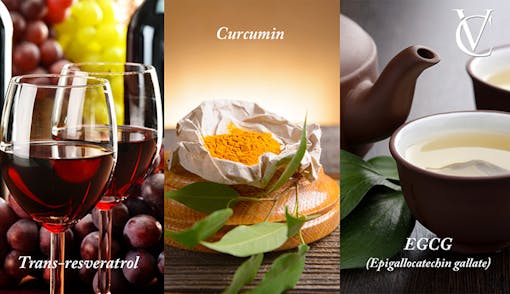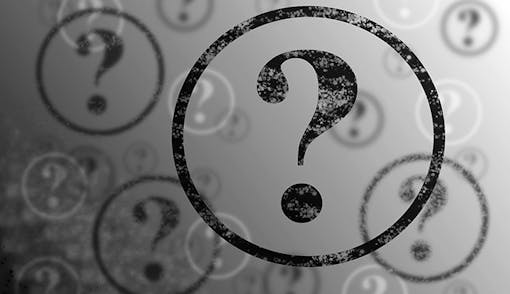This article is sponsored by PlusCBD Oil, a product line from CV Sciences (formerly CannaVest). CV Sciences is one of the leading suppliers and manufacturers of agricultural hemp-derived CBD bulk and finished products.
When reading up on cannabinoids, you may have come across some resources insinuating that some non-cannabis compounds work as well as the cannabinoids they emulate. Not so fast, friend! Today we’re going to dive into the compounds that mimic cannabinoids to see if and how they comparatively affect the endocannabinoid system, or ECS.
Do These Plant Polyphenols Affect the Endocannabinoid System?

Do any of these rockstar compounds sound familiar?
- Trans-resveratrol, the active ingredient in grape skins, red wine, and various berries
- Curcumin, the active ingredient in turmeric
- Epigallocatechin-3-O-gallate (EGCG), the active ingredient in green tea
It just so happens that in addition to having notable health benefits such as anti-inflammatory, antioxidant, cardioprotective, and neuroprotective properties, the above plant polyphenols affect the ECS, but what does that mean?
Indeed, researchers have demonstrated that under certain experimental conditions, the following can inhibit the enzymes that break down endocannabinoids, interact with cannabinoid receptors, and/or influence the availability of certain phospholipid precursors used to synthesize endocannabinoids (Gertsch et al. 2010):
- Naturally occurring fatty acid derivatives such as those from Theobroma cacao and Echinacea
- Terpenes like β-caryophyllene, pristimerin, and euphol
- Polyphenols such as trans-resveratrol, curcumin, and 7-hydroxyflavone.
However, while it’s tempting to claim that these effects on the ECS are directly responsible for the health benefits of these compounds, this conclusion is speculative and premature. In other words, let’s pump the brakes for a minute.
Are There Weight Loss Benefits in Polyphenols?

For example, an initial study reported that the polyphenols trans-resveratrol, curcumin, and epigallocatechin-3-O-gallate (found in varieties of tea leaves) were all able to bind (albeit weakly) to the human CB1 receptor (Seely et al. 2009). These compounds have also displayed substantial weight loss benefits in mice, similar to the effects of the CB1 receptor inverse agonist rimonabant. What does all that mean?
An inverse agonist is an agent that binds to the same receptor as an agonist but activates an opposing pharmacological response. Rimonabant is an inverse agonist for the cannabinoid receptor CB1, and its main effect is to reduce appetite. Just because a natural compound has “binding affinity” to CB1 or CB2 receptors does not necessarily mean that the binding is functionally or biologically relevant.
In other words, given what we know about the weight loss effects the three polyphenols appeared to have in mice, their weak interaction with CB receptors is unlikely to play a direct role. In fact, the binding affinities and downstream signaling appear to be very marginal at best.
What Does It All Mean?

A much more plausible explanation is that these compounds promote changes in insulin sensitivity/signaling, carbohydrate and fat metabolism in the liver and muscle, and even the microbiome (i.e., the organisms that reside in our gastrointestinal tract) that favor weight loss. That said, each of these physiologic mechanisms and pathways tend to overlap or crossover with many observed effects of the ECS (i.e., alterations in whole-body energy/calorie homeostasis, glucose/lipid metabolism, hunger/satiety).
At the end of the day, crossover, duplicitous action, or redundant phenotypic outcomes does not necessarily mean the same biochemical or molecular pathway is being used as the actual mechanism by which a compound “works its belly-bustin’ magic”…but it’s still fun to speculate!
References:
Järbe TUC, LeMay BJ, Halikhedkar A, et al. Differentiation between low- and high-efficacy CB1 receptor agonists using a drug discrimination protocol for rats. Psychopharmacology. 2014;231(3):489-500.
Seely KA, Levi MS, Prather PL. (2009). The dietary polyphenols trans-resveratrol and curcumin selectively bind human CB1 cannabinoid receptors with nanomolar affinities and function as antagonists/inverse agonists. J Pharmacol Exp Ther 330:S31–S39. Retraction In: Prather PL, Seely KA, Levi MS. Notice of retraction. J Pharmacol Exp Ther. 2009 Dec;331(3):1147.
Gertsch J et al. (2010). Phytocannabinoids beyond the Cannabis plant – do they exist? British Journal of Pharmacology 160: 523–529.






